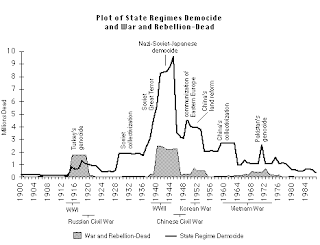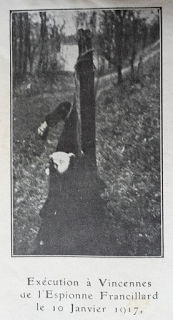The martyrdom of St. Eulalia by John William Waterhouse (1885). It is a shocking painting and, for us, it is debatable (to say the least) that the body of a dead woman could be considered as a form of art. Yet, it is also true that the history of humankind is mostly about killing people, men and women, and we cannot ignore that. In this specific painting, the position of the dead woman seems to have been chosen in order to portray her as an innocent victim and inspire piety in the viewer. That may tell us something about why there are no photos showing the body of Mata Hari after she was executed for espionage in Vincennes, in 1917. She was to be described as a monster, not as a victim.

Pictures of dead people still hanging from the stake were they had been shot were relatively common during the first world war. They were part of the propaganda of the time and were used as ways to show people that justice was being meted out against spies and traitors. You see here an example: Marguerite Francillard, killed in Paris in 1917, accused of espionage for the Germans.
There are many more pictures like this one that can be found on the Web. Julie Wheelwright (the author of "
The Fatal Lover") tells me that she interviewed the son of Pierre Bouchardon, one of the prosecutors of espionage cases during the 1st world war in France and that he had a whole journal where his father kept the photos of executed people.
But, if we have the photo of Marguerite Francillard, why don't we have one for Mata Hari, who was executed for the same reason, in the same place, just a few months later? Actually, there are several pictures that you can find on the web purporting to be real photos of the execution, but all of them are obviously fake. There is one exception, perhaps, for this one:

This photo comes from the archives of Roger Viollet, it has a catalog number, 72342-14, and it is labeled "The execution of Mata Hari on Oct 14th, 1917." Of course, there has to be something wrong with the date, because the execution was on Oct 15th, but that may simply be a typo. Apart from the wrong date, several details of the photo agree with the only description we have written by a person who was present at the execution, Emile Massard in his 1926 book "Espionnes à Paris". The two cars, the mounted dragoons, soldiers armed with rifles, and the trees that could be those of the park of Vincennes, near Paris. Incidentally, the car in the foreground seems to be a Clement-Bayard, probably a 4M model, which was manufactured before the war in France. Its presence fits well with the date of the photo. Only one detail seems to be missing: the hill in front of which Mata Hari stood. Maybe it is made invisible by the fog, or maybe it is outside the boundaries of the photo.
Overall, I would say that it is possible, although by no means certain, that this is an actual photo of the execution of Mata Hari. But, if it is true, it means that there was a photographer there. So, why do we have only one photo? Why a photo that shows nothing interesting? Why didn't the photographer take pictures of Mata Hari's body?
As I argued
in a previous post, executions were performed in conditions of near darkness, so that by when there was enough light for taking pictures, the only subject for photography was a dead body hanging from a pole. But, in the case of Mata Hari, there was a difference. She refused to be tied to the stake and when she was shot she collapsed on the ground. Of course, that didn't prevent taking a photo of the body but, perhaps, the fact that there was no need to untie her from the stake made it possible to remove the body more quickly than the usual. That would have left the photographer with nothing to photograph but the bystanders, as we see in the one picture we have.
That's not impossible, but there is a more intriguing possibility. That photos of Mata Hari's body were taken but were not shown or were destroyed. To explain the reasons why, take a look at the image below.
The British nurse Edith Cavell was shot by the Germans in 1915 for having helped British and French soldiers to move through Belgium, a territory occupied by the Germans. Unlike Mata Hari, Edith Cavell had really acted against Germany, as she herself confessed. Yet, the Allies used her as a powerful propaganda tool, describing her as a saintly woman brutally murdered by the savage Germans. Note how, in the image above, she is shown lying on the ground in the same helpless position that Waterhouse chose for St. Eulalia in his painting, above.
The Death of Edith Cavell was used as a very effective propaganda campaign and the Germans understood the damage that they had done to themselves. It may well be that Mata Hari was a casualty of a counter-propaganda effort by the German secret service who
maneuvered to frame Mata Hari in such a way to create an innocent victim on the other side. The plan may have been that they could then use Mata Hari as a propaganda tool, just as the allies had used Edith Cavell.
It didn't work. Mata Hari was an entertainer of dubious reputation; there was no way she couldn't be presented as a saintly woman in the same way as Edith Clavell, the nurse, was. Nevertheless, the German plan was dangerous for the French and they had to be very careful in the way they presented the execution of Mata Hari in the press.
Now, imagine that on the day after the execution the pictures of the dead body of Mata Hari are presented to a group of high-ranking French officials. They look at the body lying on the ground and they notice how similar these pictures are to those of Edith Cavell, so widely used to smear the Germans. The officers briefly look at each other and then they shake their heads: no way that these photos should be diffused. They could generate a feeling of sympathy for Mata Hari No, Mata Hari was not to be just killed, she had to be humiliated, destroyed, squashed like an insect. No images of her dead body could be allowed. And here is why we never saw those images and, probably, never will.
All this is, of course, just a series of hypotheses but everything about Mata Hari is shrouded in mystery and legend and this is the best we can do until, perhaps, these hidden images will resurface from wherever they are hidden. But it doesn't matter so much, Mata Hari was a creature of light, just as the stage name she chose for herself, meaning "The path of light" or "the light of dawn." That's the way we like to remember her.















